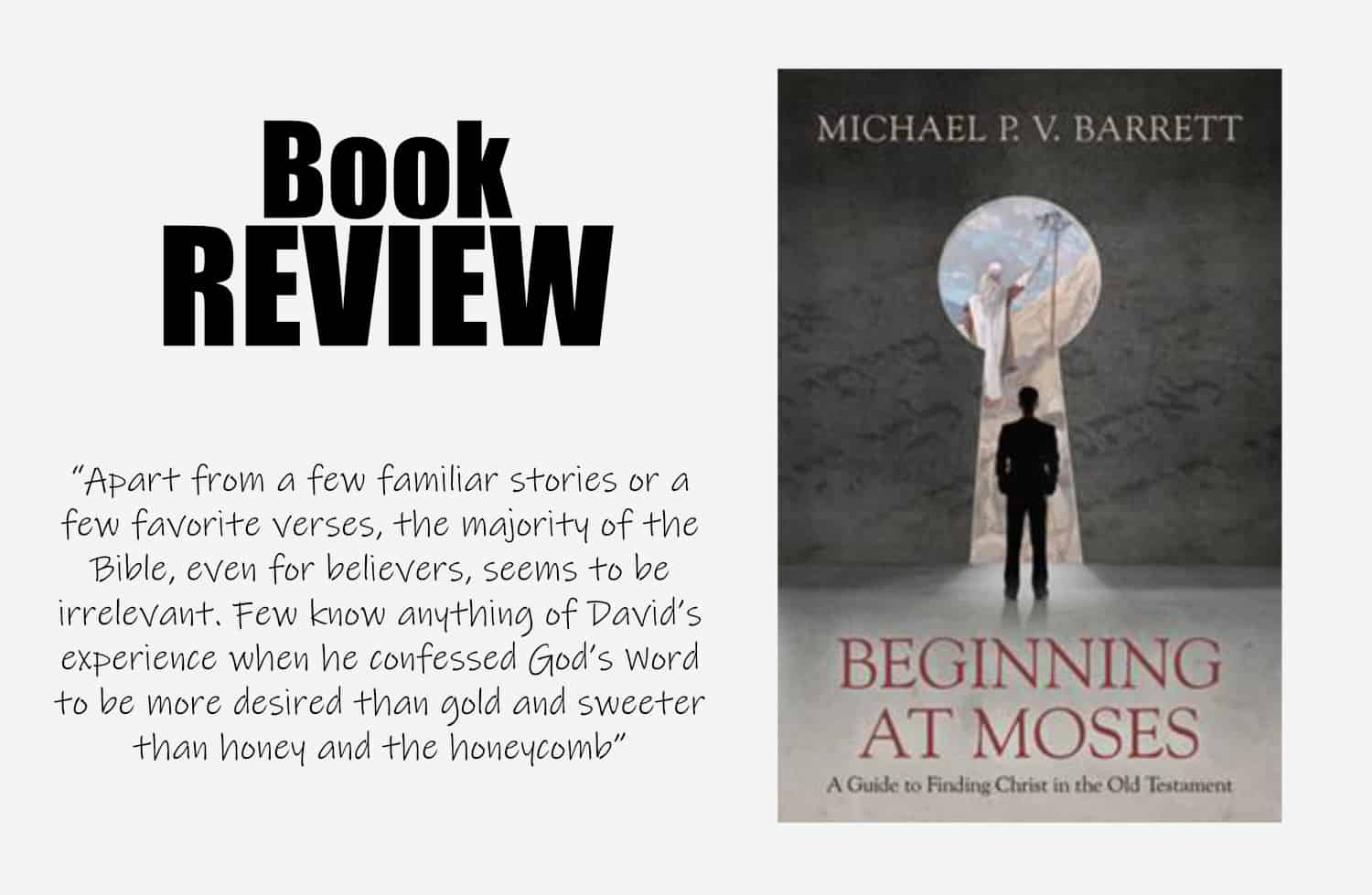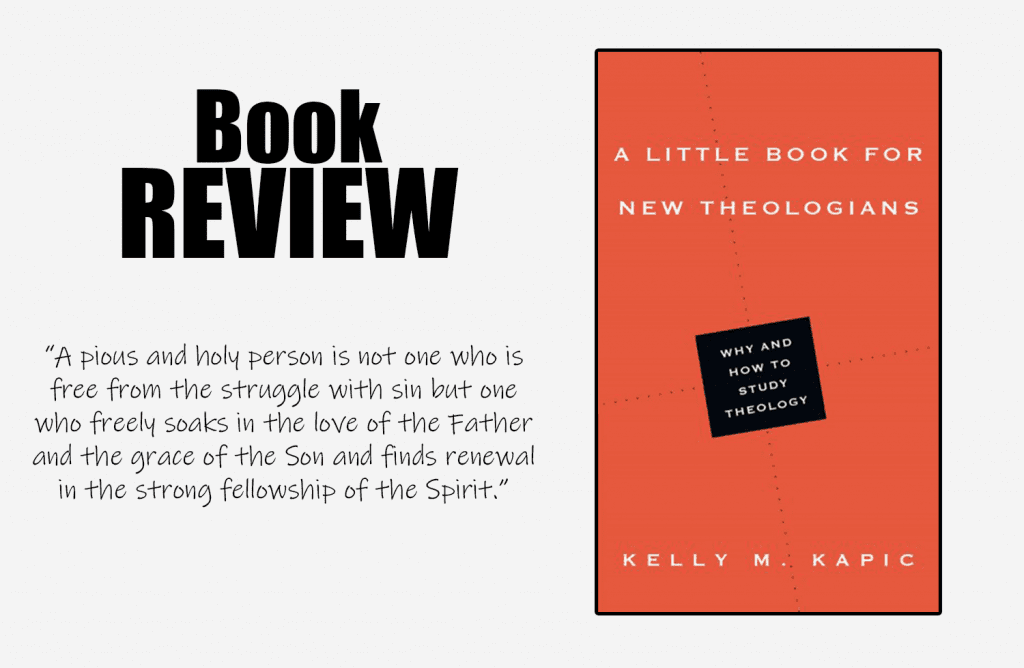Introduction
Beginning at Moses: A Guide to Finding Christ in the Old Testament was written by Michael P. V. Barrett and published by Ambassador International in 1999. Michael Barrett is the Academic Dead and Professor of the Old Testament at Puritan Reformed Theological Seminary and formerly president of Geneva Reformed Seminary. He has a doctorate in Old Testament Text focusing on Semitic languages. His theological education makes him well suited to the teaching of Old Testament theology, specifically in exegesis, which is the backbone of this work.
Summary
The aim of this book is to help readers learn to recognize both where Christ appears in the Old Testament (via christophanies and theophanies) as well as where he is foreshadowed via prophecies. Barrett understands that finding Christ in the Old Testament is easier than finding him in the new (468), so he approaches the subject from a layman’s perspective to ease the reader into this exegetical exercise. The author’s thesis is that “searching for and finding Christ is still the key that unlocks the Old Testament.” The book is divided into 2 parts: whom to look for in chapters 1-3 and where to look for him in chapters 4-10.
Part 1 deals with teaching the reader who Christ is through an analysis of his work and attributes. Chapter 1 deals with seeing Jesus as the Messiah. Barrett lists three attributes of the Messiah as presented in the Old Testament and how they relate to Christ. First, the Messiah was an elected person. God does not leave his intent up to chance, but foreordains and fulfills his will (47). Second, the Messiah had authority granted by God. Third, the Messiah had the power to fulfill his task. Christ is shown as clearly fulfilling all three messianic requirements (57).
Chapter 2 deals with the personal traits of Christ so that the reader can become familiar with and recognize Christ, even when it’s not explicitly shown (82). Christ is shown uniquely as the only qualified, willing, and able person who could fulfill the role as mediator. Christ is shown as being divine, showing the attributes of independence, eternality, omnipotence, omniscience, and omnipresence. He is also shown to perform divine works in creation, providence, and miracles. The author then looks at Christ’s human attributes. His humanity is seen in his lineage, referenced in Scripture as being a man, physical body, and rational soul.
Chapter 3 takes a deeper look at the works of Christ. The works of Christ are an important signature to identify them (115). Christ’s works are split into 3 categories. First are his past works of obedience, death, resurrection, and ascension. Second are his current works as prophet, priest, and king in his exultation. Third are his future works as judge and supreme ruler. These works are unique to Christ and if they are seen in the Old Testament, then those are areas where Christ is being displayed (153).
Part 2 teaches the reader where to look for Christ in the Old Testament using what was learned from part 1 (472). Chapter 4 focuses on seeing Christ through the various biblical covenants. Christ is shown in the Covenant with Adam and Eve, Noah, Abraham, David, Israel (Mosaic), and the new covenant. The author also draws the reader to the covenant word “seed” and how it relates to Christ. He is shown as a Man in Genesis 3:15, a semitic man in Genesis 9:27, Abraham’s seed in Genesis 12, 15, and 17, A man further narrowed down to the line of Jacob in Genesis 26:3-4, a man from the tribe of Judah in Genesis 49:10, and lastly a man from the family of David in 2 Samuel 7:12-16.
Chapter 5 focuses on the pre-incarnate appearances of Christ. An important note is that the Christophanies were when Christ appeared as a man, but had not taken on human nature as in his birth and earthly life (219). Christophanies can be identified by looking for several key ideas. The most common and direct is his appearance as an “Angel of the Lord.” This phrase is exclusively used to identify an appearance of Christ. Barrett points the reader back to Christ’s role as prophet, priest, and king. When the reader sees a Christophany, it can be verified by identifying which of these roles are being fulfilled in the passage.
Chapter 6 takes time to inform the reader of the names that are commonly associated with Christ. They are not necessarily proper names but can be nouns that act similarly to nicknames (247). These names are Wonderful Counselor, Mighty God, Father of Eternity, Prince of Peace, Corner/Corner Stone, Nail, Battle Bow, Absolute Ruler, Immanuel, Branch, Wisdom, Son of Man, Shiloh, Star, Scepter, Redeemer, Shepherd, and Servant. Other titles are listed but not given detailed explanation. These titles are said to be non-exhaustive, but since Christ is never named haphazardly, it is important to take time to learn to recognize and study them (473).
Chapter 7-9 address how Christ is referenced in prophecy. The two types of prophecy that are addressed are predictive prophecy and what the author calls picture prophecy. Predictive prophecy are those texts in which God “reveals the future to affect the present (314).” Barrett mostly focuses on developing a proper exegetical framework for predictive prophecy and then leads the reader through several Gospel important passages that focus on Christ’s time, coming, birth, ministry, death, burial, and resurrection.
Picture prophecy is the author’s way of describing typology. Christ is shown in picture prophecy through symbols, types, and antitypes. Symbols are something real that points to a moral or spiritual truth. A type “predicts the actual, future realization or fulfillment of a pictured truth.” Antitypes are those things that types point to, they are the fulfillment. The author also makes special note of the New Testament’s use of the word shadow to describe the relationship between Christ and types (374).
The author teaches how to identify and interpret types as well as how to use the New Testament as a guideline for the proper exegesis of types. Barrett makes a point of distinguishing between “divinely intended” types, those that God created and exist within the text, and those types that Christians push onto the (402). Finishing the trifecta of chapters, the author addresses several categories of types: people (through their office and not character (403)), things (particularly the tabernacle), and events.
The final chapter (other than the conclusion) is about seeing Christ in worship, focusing on the book of Psalms. The author takes time to teach on identifying messianic psalms and the importance of Christ-centeredness in worship. Garrett states that “There is hardly a truth about Christ and His work that does not find some expression in the Psalms (475).” Singing is shown as a natural expression of human affection toward God and the Psalms are a guideline for proper worship.
Evaluation
This book is well organized, thorough, and accomplished the goal of teaching the reader to see Christ in the Old Testament. It also provides good introductory primers on various topics, like covenant theology and typology. However, while its thoroughness makes the book comprehensive, it also becomes its greatest weakness.
First, the book is divided well. The two major parts are helpful in guiding the reader through the proper mental procedure for exegeting Christ in the Old Testament. The author’s basic premise of first understanding who Christ is, what he is like, and how he works is a helpful reminder to this reader about the preeminence of Jesus in our exegetical pursuit. The author displays his great love and understanding of who Christ is and represents him well.
Fulfilling his goal, the author has consistency in using the tools taught in part 1 to approach Christ in the Old Testament. It seems common for authors to teach the reader a method in the first part of a work and forget to apply it in the second half. This is not to say that the second half is untrue in other works, but Barrett’s consistency in applying what he is teaching is refreshing and admirable.
Speaking specifically about the chapters in part 2, they were split into categories that felt natural to the Old Testament. The author never felt as though he had a framework developed that he was trying to make the Old Testament fit into, but that the chapters came naturally from the text. This natural division makes future application of what was taught easier to remember and apply. Another benefit of this natural division is that the theology that Barrett presents is also accurate, with no major contentions from this reader other than tertiary issues like the end-times.
The goal of the book was to teach the reader to see Christ in the Old Testament, and in that it was successful. Barrett thoroughly addressed most of the major Old Testament references to Christ. While nothing he spoke about was profound, and I’m not saying it should have been, this book will become a great reference material for this reader’s future study.
One area where the author succeeded exceptionally was his primers on both Covenant theology and typology. He was direct and included all necessary information on both topics without becoming long-winded or overbearing. His discussion on covenants was to the point, and he did not get distracted by opposing theology or trying to defend his case from all arguments. This was incredibly refreshing and speaks highly of the author’s confidence in his content and of his teaching ability. His discussion on typology was much the same. He stayed on topic and presented the exegesis of typology in a friendly and easy-to-understand way. This book was intended for laypeople, and his condensing of these two topics would have been helpful to this reader’s theology earlier in life.
The book thoroughness is one of its major benefits but also becomes one of it’s major drawbacks. The book’s goal is certainly met in teaching the reader how to find Christ in the Old Testament, but the author goes beyond that and seems to better accomplish the goal of showing the reader where Christ is in the Old Testament. Both goals are similar, but with how thorough the author attempts to be, the book soon becomes boring, feeding the reader information rather than showing how the tools are used and trusting that the reader will make use of them on the unaddressed passages.
The reader would have been served well by reducing the number of examples and retaining the reader’s interest, rather than trying to cover such a large quantity of passages. This reader felt that the lack of unanswered questions removed a desire to take the methods and begin to apply them. When finished reading, this book felt more like a reference book, which is a fine goal for a book, but seems as though it fell short of the foundational first part, and main goal, of the work.
Conclusion
This book does an excellent job of providing a foundational understanding of the person and work of Christ as well as covenant theology and typology. These tools are necessary to any proper understanding of the Old Testament. I would recommend this book to newer Christians or to Christians who struggle to see the importance of the Old Testament or find its content irrelevant to the new covenant church.



